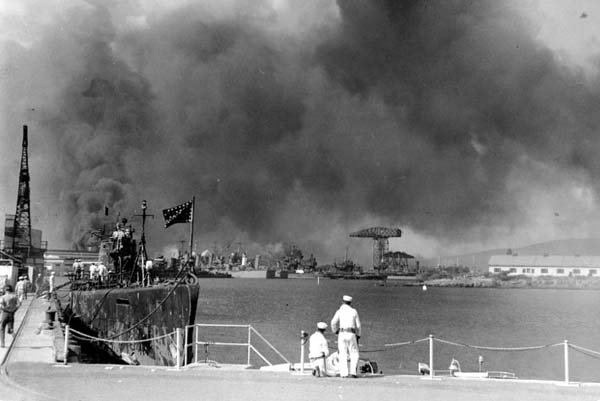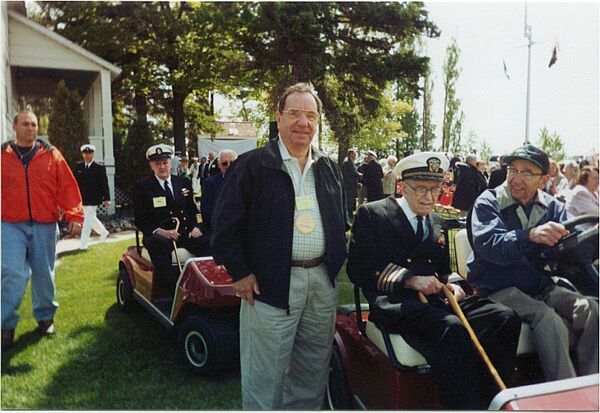FROM DESTROYERS TO SUBMARINES
COMMENTS BY FRANK RUMA, TM1(SS), LEADING
TORPEDOMAN IN THE FORWARD TORPEDO ROOM OF THE USS DARTER (SS-227); THEN,
THE FIRST TMC(SS) OF THE USS MENHADEN (SS-377)
I was at Pearl Harbor, Hawaii, on December 7, 1941, when the
Japanese attacked. I was on temporary duty at the Submarine Base at the
time servicing torpedoes from the USS Schley (DD-103), on which I was a
permanent crew member. Schley was going through a complete overhaul at
the Navy Yard across the channel in Pearl Harbor from the Sub Base. I believe
she was tied up across from the cruiser, Honolulu, which was bombed. Schley,
I also believe, was being converted to an APD, which would transport Marines
for fast beach landings in some of the future battles to come in the South
Pacific.
Although the Sub Base was only strafed with machine gun bullets
from the Japanese planes during the attack, it turned out to be a super
blunder by the Japs for not bombing it. It remained intact and was able
to supply submarines with torpedoes without disruption during the entire
War to conduct their Patrols and sink Japanese shipping.
I did not really get involved in doing anything except to witness
the flight of the Japanese planes making their run down the channel, dropping
torpedoes into the water which sank the battleships, Arizona, Oklahoma
and California. The Japanese planes were so close to the Submarine Base
in making their torpedo runs and dive bombing that I could have thrown
rocks and hit some of the planes.
 View looking toward the Navy Yard from the Submarine Base during
the Japanese attack on Pearl Harbor, December 7, 1941. The submarine in
the left foreground is the USS Narwhal (SS-167). In the distance are several
cruisers, with large cranes and the 1010 Dock in the right center.
(Official U.S. Navy Photograph. Image Courtesy of the Naval
Historical Center, Washington, D.C.)
I was a Third Class Torpedoman during the Japanese attack. After
the attack and the completion of my destroyer's overhaul, I returned in
January or February, 1942, to my ship with the 12 torpedoes. We were assigned
to patrol the mouth (entrance) to Pearl Harbor. During the few months that
I was still on Schley, we made many attacks on Japanese submarines while
patrolling the entrance. On one occasion, my watch was on the bridge of
the destroyer when contact was made with a Japanese submarine. Our sonar
system picked it up and we dropped several, probably 16 depth charges,
since each depth charge rack on our stern held eight depth charges each.
I was the person who released the depth charges when given the command
to do so by the Skipper of Schley. I believe our destroyer got credit for
sinking a Jap submarine this time.
Shortly thereafter, I was sent to the States to put a new destroyer
into commission. I want you to know that when the War started in December,
1941, the entire U.S. Navy complement was only about 250,000. I believe
when the War ended in August, l945, it had grown to 1,900,000. So you can
readily see that not only were submarines sending their seasoned trained
sailors to new construction, but destroyers were doing the same. I was
in a most needed rating and left in 1942 to put a new destroyer in commission
in Newport News, VA. But first, the Navy was coming out with a new destroyer
torpedo and I was sent to Newport, Rhode Island, to attend an Advanced
School.
Now comes the rub. Guess who was my Class Instructor? . . .
Yep, you guessed it. An old Retired Submarine Chief, who was recalled to
active duty to teach. Now I am a 21-year old qualified Torpedoman, and
the Submarine Service was in dire need of them. He sort of wined and dined
me to transfer into the Sub Service. I had recently met the girl I was
later to marry, Laura Leible, in St. Louis, before I went to the Torpedo
School and I made a deal with him. If he could get me a couple weeks leave,
I would transfer to the Submarine Base in New London. He agreed and that
is how I got into submarines.
After attending Submarine School, I was flown to Pearl Harbor
and was promoted to First Class Torpedoman. I was assigned to the USS Permit
(SS-178), and made one War Patrol on her with "Moon" Chapple out of Pearl
Harbor. After qualification, I was assigned to Orion, the submarine tender,
and went to Brisbane, Australia, where I picked up Darter going out on
her Second War Patrol in March, 1944.
The Chief of the Boat was a Chief Gunner's Mate, and the Chief
Torpedoman was sent to the States for new construction. I then took over
the Forward Torpedo Room on the Darter. Her Skipper was William S. Stovall,
a good buddy of "Moon" Chapple. We had some nice discussions. He had been
on many War Patrols and was relieved of command prior to the Third War
Patrol.
I was lucky enough to be on the bridge one night on our Second
War Patrol when Darter made a surface attack on a Japanese ship. We were
patrolling somewhere around Borneo, I believe. I understand that Japan
was getting their oil from there and were patrolling the entrance of a
harbor. I decided to get some fresh air and took the forward lookout station.
We spotted a Jap ship and immediately attacked it. I was fortunate enough
to see our torpedoes hit and sink it. Immediately after firing, we turned
tail and headed back out to deep water.
David McClintock was put in command of Darter in June, 1944.
Also relieved was Dick Gebhardt, the Executive Officer. Ernie Schwab became
her Exec and Denny Wilkinson, later to command the first atomic submarine,
the USS Nautilus (SSN-571), was promoted from Gunnery/Torpedo Officer to
Engineering Officer. When he was the Torpedo Officer, we had some great
discussions and played a lot of cribbage and acey duecy on Darter.
View looking toward the Navy Yard from the Submarine Base during
the Japanese attack on Pearl Harbor, December 7, 1941. The submarine in
the left foreground is the USS Narwhal (SS-167). In the distance are several
cruisers, with large cranes and the 1010 Dock in the right center.
(Official U.S. Navy Photograph. Image Courtesy of the Naval
Historical Center, Washington, D.C.)
I was a Third Class Torpedoman during the Japanese attack. After
the attack and the completion of my destroyer's overhaul, I returned in
January or February, 1942, to my ship with the 12 torpedoes. We were assigned
to patrol the mouth (entrance) to Pearl Harbor. During the few months that
I was still on Schley, we made many attacks on Japanese submarines while
patrolling the entrance. On one occasion, my watch was on the bridge of
the destroyer when contact was made with a Japanese submarine. Our sonar
system picked it up and we dropped several, probably 16 depth charges,
since each depth charge rack on our stern held eight depth charges each.
I was the person who released the depth charges when given the command
to do so by the Skipper of Schley. I believe our destroyer got credit for
sinking a Jap submarine this time.
Shortly thereafter, I was sent to the States to put a new destroyer
into commission. I want you to know that when the War started in December,
1941, the entire U.S. Navy complement was only about 250,000. I believe
when the War ended in August, l945, it had grown to 1,900,000. So you can
readily see that not only were submarines sending their seasoned trained
sailors to new construction, but destroyers were doing the same. I was
in a most needed rating and left in 1942 to put a new destroyer in commission
in Newport News, VA. But first, the Navy was coming out with a new destroyer
torpedo and I was sent to Newport, Rhode Island, to attend an Advanced
School.
Now comes the rub. Guess who was my Class Instructor? . . .
Yep, you guessed it. An old Retired Submarine Chief, who was recalled to
active duty to teach. Now I am a 21-year old qualified Torpedoman, and
the Submarine Service was in dire need of them. He sort of wined and dined
me to transfer into the Sub Service. I had recently met the girl I was
later to marry, Laura Leible, in St. Louis, before I went to the Torpedo
School and I made a deal with him. If he could get me a couple weeks leave,
I would transfer to the Submarine Base in New London. He agreed and that
is how I got into submarines.
After attending Submarine School, I was flown to Pearl Harbor
and was promoted to First Class Torpedoman. I was assigned to the USS Permit
(SS-178), and made one War Patrol on her with "Moon" Chapple out of Pearl
Harbor. After qualification, I was assigned to Orion, the submarine tender,
and went to Brisbane, Australia, where I picked up Darter going out on
her Second War Patrol in March, 1944.
The Chief of the Boat was a Chief Gunner's Mate, and the Chief
Torpedoman was sent to the States for new construction. I then took over
the Forward Torpedo Room on the Darter. Her Skipper was William S. Stovall,
a good buddy of "Moon" Chapple. We had some nice discussions. He had been
on many War Patrols and was relieved of command prior to the Third War
Patrol.
I was lucky enough to be on the bridge one night on our Second
War Patrol when Darter made a surface attack on a Japanese ship. We were
patrolling somewhere around Borneo, I believe. I understand that Japan
was getting their oil from there and were patrolling the entrance of a
harbor. I decided to get some fresh air and took the forward lookout station.
We spotted a Jap ship and immediately attacked it. I was fortunate enough
to see our torpedoes hit and sink it. Immediately after firing, we turned
tail and headed back out to deep water.
David McClintock was put in command of Darter in June, 1944.
Also relieved was Dick Gebhardt, the Executive Officer. Ernie Schwab became
her Exec and Denny Wilkinson, later to command the first atomic submarine,
the USS Nautilus (SSN-571), was promoted from Gunnery/Torpedo Officer to
Engineering Officer. When he was the Torpedo Officer, we had some great
discussions and played a lot of cribbage and acey duecy on Darter.
 Frank Ruma standing beside Captain David H. McClintock at the
Dedication Ceremony of the Darter/Dace Submariner Memorial in Marquette,
Michigan, May 27th, 2000.
(Image Courtesy of Frank Ruma, TM1(SS),
Darter, 3/44-10/44; and TMC(SS), Menhaden, 6/45-10/45)
Frank Ruma standing beside Captain David H. McClintock at the
Dedication Ceremony of the Darter/Dace Submariner Memorial in Marquette,
Michigan, May 27th, 2000.
(Image Courtesy of Frank Ruma, TM1(SS),
Darter, 3/44-10/44; and TMC(SS), Menhaden, 6/45-10/45)



